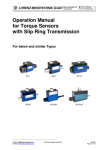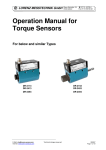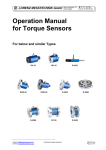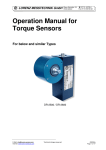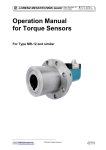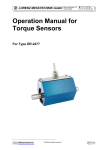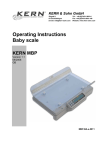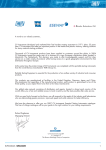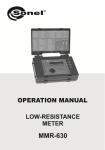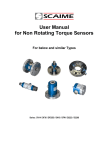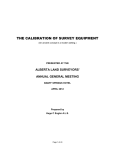Download Operation Manual for Force Sensors
Transcript
LORENZ MESSTECHNIK GmbH Obere Schloßstr.131 73553 Alfdorf 07172 / 93730-0 Fax 07172 /93730-22 Operation Manual for Force Sensors E-Mail: [email protected] Internet: www.lorenz-sensors.com Technical changes reserved 090273.doc Page 1 of 14 LORENZ MESSTECHNIK GmbH Obere Schloßstr.131 73553 Alfdorf 07172 / 93730-0 Fax 07172 /93730-22 Imprint Manufacturer, Place Lorenz Messtechnik GmbH, D-73553 Alfdorf Valid for... Force Sensors Copyright © 2007 Lorenz Messtechnik GmbH, Alfdorf. Reprint-Interdiction Reprint, even in extracts, only with written authorization. Modification Technical changes reserved. References in this Text 1.6 Warning Notes; Page 4 Attention must be paid to the accident prevention regulations of the trade associations. During operation, the safety precautions must be operative. 5.1 General Requirements; Page 7 Caution: During the assembly inadmissibly large forces may not act on the sensor. At small nominal forces (< 100 N) connect the sensor electrically during the assembly and observe the signal, the measurement signal may not exceed the limit values. 5.2.4 Fix Assembly; Page 8 The assembly without balancing elements is problematic for the operating safety! 7.1 Engaging; Page 11 The warming-up period of the force sensor is approx. 5 min. 7.3.2 Natural Resonances; Page 11 An operation of the device in natural resonance can lead to permanent damages. E-Mail: [email protected] Internet: www.lorenz-sensors.com Technical changes reserved 090273.doc Page 2 of 14 LORENZ MESSTECHNIK GmbH Obere Schloßstr.131 73553 Alfdorf 07172 / 93730-0 Fax 07172 /93730-22 Contents 1 Read First .............................................................................................................................................................. 4 1.1 Safety and Caution Symbols ......................................................................................................................... 4 1.2 Intended Use ................................................................................................................................................. 4 1.3 Dangers ......................................................................................................................................................... 4 1.3.1 Neglecting of Safety Notes .................................................................................................................... 4 1.3.2 Remaining Dangers ............................................................................................................................... 4 1.4 Reconstructions and Modifications ................................................................................................................ 4 1.5 Personnel ...................................................................................................................................................... 4 1.6 Warning Notes ............................................................................................................................................... 4 2 Term Definitions .................................................................................................................................................... 5 2.1 Direction of Force .......................................................................................................................................... 5 2.2 Spring Constant............................................................................................................................................. 5 3 Product Description ............................................................................................................................................... 5 3.1 Mechanical Setup .......................................................................................................................................... 5 3.2 Electrical Setup.............................................................................................................................................. 6 4 Construction and Design ....................................................................................................................................... 6 4.1 Calculation Example for an Accelerated Mass .............................................................................................. 6 5 Mechanical Assembly............................................................................................................................................ 7 5.1 General Requirements................................................................................................................................... 7 5.2 Further Notes................................................................................................................................................. 7 5.2.1 Face - Face............................................................................................................................................ 7 5.2.2 Face - Convex ....................................................................................................................................... 8 5.2.3 Joint Eyes .............................................................................................................................................. 8 5.2.4 Fix Assembly ......................................................................................................................................... 8 5.3 Overload Protection ....................................................................................................................................... 8 5.3.1 Measuring Path...................................................................................................................................... 8 5.3.2 Simple Overload Protection ................................................................................................................... 9 5.3.3 Measuring Path Magnification................................................................................................................ 9 6 Electrical Connection........................................................................................................................................... 10 6.1 Pin Connection ............................................................................................................................................ 10 6.2 Free Cable Ends.......................................................................................................................................... 10 6.3 Cables ......................................................................................................................................................... 10 6.4 Shielding Connection................................................................................................................................... 10 6.5 Extension Cables......................................................................................................................................... 10 6.6 Running of Measuring Cables ..................................................................................................................... 11 7 Measuring............................................................................................................................................................ 11 7.1 Engaging ..................................................................................................................................................... 11 7.2 Static / Quasi-Static Forces ......................................................................................................................... 11 7.3 Dynamic Forces........................................................................................................................................... 11 7.3.1 General................................................................................................................................................ 11 7.3.2 Natural Resonances ............................................................................................................................ 11 7.4 Disturbance Variables.................................................................................................................................. 11 7.4.1 Temperature ........................................................................................................................................ 11 7.4.2 Humidity............................................................................................................................................... 12 7.4.3 Gases .................................................................................................................................................. 12 7.4.4 Radioactivity ........................................................................................................................................ 12 7.4.5 Vacuum ............................................................................................................................................... 12 7.4.6 Mechanical Disturbances..................................................................................................................... 12 7.4.7 EMC..................................................................................................................................................... 12 7.5 Calibration Control (Option) ......................................................................................................................... 12 8 Maintenance ........................................................................................................................................................ 13 8.1 Maintenance Schedule ................................................................................................................................ 13 8.2 Trouble Shooting ......................................................................................................................................... 13 9 Decommission ..................................................................................................................................................... 13 10 Transportation and Storage ............................................................................................................................. 13 10.1 Transportation ......................................................................................................................................... 13 10.2 Storage .................................................................................................................................................... 13 11 Disposal........................................................................................................................................................... 14 12 Calibration ....................................................................................................................................................... 14 12.1 Proprietary Calibration ............................................................................................................................. 14 12.2 DKD-Calibration....................................................................................................................................... 14 12.3 Re-Calibration.......................................................................................................................................... 14 13 Data Sheet....................................................................................................................................................... 14 14 Literature ......................................................................................................................................................... 14 E-Mail: [email protected] Internet: www.lorenz-sensors.com Technical changes reserved 090273.doc Page 3 of 14 LORENZ MESSTECHNIK GmbH 1 Read First 1.1 Safety and Caution Symbols Obere Schloßstr.131 73553 Alfdorf 07172 / 93730-0 Fax 07172 /93730-22 Caution: Injury Risk for Persons Damage of the Device is possible Note: Important points to be considered 1.2 Intended Use Force sensors are intended for the measurement of forces in test benches, assembly-force appliances, presses and testing machines. This measurand is suitable for control and regulation tasks. The valid safety regulations must be absolutely respected. The force sensors are not safety components in the sense of the intended use. The sensors need to be transported and stored appropriately. The assembly, commissioning and disassembling must take place professionally. 1.3 Dangers The force sensor is fail-safe and corresponds to the state of technology. 1.3.1 Neglecting of Safety Notes At inappropriate use, remaining dangers can emerge (e.g. by untrained personnel). The operation manual must be read and understood by each person entrusted with the assembly, maintenance, repair, operation and disassembly of the force sensor. 1.3.2 Remaining Dangers The plant designer, the supplier, as well as the operator must plan, realize and take responsibility of safety-related interests for the sensor. Remaining dangers must be minimized. Remaining dangers of the force measurement technique must be pointed out. 1.4 Reconstructions and Modifications Each modification of the sensors without our written approval excludes liability on our part. 1.5 Personnel The installation, assembly, commissioning, operation and the disassembly must be carried out by qualified personnel only. The personnel must have the knowledge and make use of the legal regulations and safety instructions. 1.6 Warning Notes Attention must be paid to the accident prevention regulations of the trade associations. During operation, the safety precautions must be operative. E-Mail: [email protected] Internet: www.lorenz-sensors.com Technical changes reserved 090273.doc Page 4 of 14 LORENZ MESSTECHNIK GmbH 2 Term Definitions 2.1 Direction of Force Compression Force Tension Force Compression Force Sensor Tension Force Sensor Tension and Compression Force Sensor Compression and Tension Force Sensor Obere Schloßstr.131 73553 Alfdorf 07172 / 93730-0 Fax 07172 /93730-22 Tension and Compression Force Compression Force Tension Force Tension Force Compression Force =ˆ =ˆ =ˆ =ˆ Positive Output Signal Positive Output Signal Positive Output Signal Positive Output Signal F 2.2 Spring Constant Under compression force F the measuring body is jolted by the amount ∆l . The spring constant is calculated according: c= Spring constant c of a sensor 3 F ∆l l d l - ∆l d + ∆d Product Description The sensor measures static and dynamic forces. The mounting position of the force sensor is horizontal or vertical. 3.1 Mechanical Setup The force sensor consists of a measuring body and a housing. By the introduced force, mechanical tensions occur in the measuring body which are measured by strain gauges (SG). Since the obtained measuring signal is very small, the SG are interconnected to a full bridge. By the bridge connection, the temperature compensation is obtained as well. There are following types of force sensors: Measuring Body SG Housing Compression Cylinder with Drilling Membrane Force Tension Rod Bending Beam Bending Beam Shear Force E-Mail: [email protected] Internet: www.lorenz-sensors.com Technical changes reserved 090273.doc Page 5 of 14 LORENZ MESSTECHNIK GmbH 3.2 Obere Schloßstr.131 73553 Alfdorf 07172 / 93730-0 Fax 07172 /93730-22 Electrical Setup Excitation + The SG-Full Bridge is led-out directly to the connector or the cable. Optionally a control was inserted. For this, the SG-Full Bridge gets detuned in such a way that at the output a measuring signal can be measured which corresponds to the nominal force. R2 External Switch R1 RK Signal + R3 R4 Signal - Excitation Sensor 4 External Construction and Design Please clarify following points at the beginning of the construction: • • • • • • • • • • Required space for the connection cable. For equipment monitoring (calibration), the sensor must be easily demountable. If necessary, provide a dummy for assembly and test runs. Consider required space for overload protection. Consider requirements of the force introduction faces. Determine maximum load (accelerated masses generate forces as well). Dynamic characteristics of the setup. Ambient conditions. Temperature gradients. Impact of temperature changes to the setup For further indications see chapter Assembly. • 4.1 Consider electrical measuring devices (for test and trouble-shooting as well). Calculation Example for an Accelerated Mass Example Mass m falls on a plate with celerity v; by this, force peaks emerge (acceleration, deceleration). Kinetic energy of the mass m v Ev = ½ m·v² Demonstration shortly before the collision F Brake energy EB = F·s The brake distance s must be estimated. s Demonstration of max. brake force Example v = 1 m/s = 3,6 km/h; m = 1 kg Ev = 0,5 kg·m²/s² braking Weight force s = 0,1 mm EB = F·s = Ev F = Ev / s = 0,5 kg·m²/s²/0,0001m = 5000 kg·m/s² = 5000 N Weight force = m·g with g = local acceleration of fall Demonstration in resting state E-Mail: [email protected] Internet: www.lorenz-sensors.com Technical changes reserved 090273.doc Page 6 of 14 LORENZ MESSTECHNIK GmbH 5 Mechanical Assembly 5.1 General Requirements Obere Schloßstr.131 73553 Alfdorf 07172 / 93730-0 Fax 07172 /93730-22 Requirements of the bearing surface and the force introduction faces: Surfaces hardened to HRC 50, grinded and/or lapped, roughness Rz 4, evenness 0,02 mm. At possible overload, an overload protection should be considered. For calibration, the sensor must be easily demountable. Assembly: • The base frame of the force sensor must show a preferably plane mounting surface (evenness 0,02 mm). • The base frame must be free from dirt, grease and dust. • Do not overload the sensor during the assembly. (Even a short term overload can damage the sensor) • Preferably use dummies for the alignment of the mechanic introduction parts. • The force introduction must be carried out punctiform. • The load conduct, the force introduction components and the force sensor must be connected to each other rigidly and free from backlash. • The lead-in forces should always act on the force sensor in the sensor specific direction of measurement (see data sheet). By this, the applied load and the force sensor form a continuous line of action. • Loading the sensor with shearing forces, lateral forces and torque must be absolutely avoided, even small shearing forces can generate larger uncertainties of measurement. In addition, the spring body (depending on the measuring range) can be plastically deformed. • At flexible mounting positions, especially pendulous assembly in tension direction, we recommend the joint balls listed on the data sheet for the force introduction. • Force shunts (cables, hoses, pipes etc.) must be avoided. Caution: During the assembly inadmissibly large forces may not act on the sensor. At small nominal forces (< 100 N) connect the sensor electrically during the assembly and observe the signal, the measurement signal may not exceed the limit values. Force Direction = Measuring Direction of the Sensor (Geometric Axis) Always treat the sensor with care. 5.2 Further Notes 5.2.1 Face - Face Wrong!!! Acting Force Measuring Axes of the Force Sensor ⇒ Faces always plane (preferably grinded) ⇒ Faces always parallel to each other ⇒ Force introduction always measuring axis E-Mail: [email protected] Internet: www.lorenz-sensors.com Technical changes reserved 090273.doc Page 7 of 14 LORENZ MESSTECHNIK GmbH Obere Schloßstr.131 73553 Alfdorf 07172 / 93730-0 Fax 07172 /93730-22 5.2.2 Face - Convex The convex introduction balances small angular deviations of the introduction levels. Error ~ (1 – cos(α)) e.g. a = 1,8° Error related to the final value 0,05% 2•α ⇒ Faces always plane (preferably grinded) ⇒ Minimize angular errors Sensor must bear on the complete face 5.2.3 Joint Eyes Avoid lateral forces at tension force sensors ⇒ Balance of axial offset ⇒ Force introduction in axial direction ⇒ Not suitable for compression forces!!! Acting Force 5.2.4 Fix Assembly Acting Force The assembly without balancing elements is problematic for the operating safety! ⇒ The introduction must occur free of lateral forces ⇒ Torque may not arise in the sensor ⇒ The introduction faces must be parallel to each other (axial force introduction) The temperature elongation of the parts must be considered! The effect can not be planned. 5.3 Overload Protection 5.3.1 Measuring Path Estimate of the measuring path of the sensor Double bending beam Membrane Shear force; Compression cylinder 0,01 0,1 1 Measurement range in mm Typical values of the measuring path at force sensors. Further must be considered: Contact stiffness (stiffness of the transit of the introduction part to the sensor) Stiffness of the introduction parts etc. E-Mail: [email protected] Internet: www.lorenz-sensors.com Technical changes reserved 090273.doc Page 8 of 14 LORENZ MESSTECHNIK GmbH 07172 / 93730-0 Fax 07172 /93730-22 Obere Schloßstr.131 73553 Alfdorf Example for the estimate of the complete spring stiffness of a force measurement layout at minimum, these spring constants must be considered: ⇒ of the sensor ⇒ of the contact faces ⇒ of the introduction parts Mechanic spring parts Setup Example Introduction parts Contact Sensor Contact Introduction parts Introduction face 5.3.2 Simple Overload Protection Force Caution! Normally the measuring path is very small. For a simple overload protection, a dead stop, grinded to the corresponding dimension, can be manufactured. All parts must be grinded and hardened. Accurate alignment of the faces is necessary. Path for dead stop Path for dead stop = Measuring path at nominal force·1,1 Path for dead stop Dead stop Force sensor Dead stops Overload protection for bending beam (large measuring path) Sensor 5.3.3 Measuring Path Magnification The path for the dead stop gets magnified by a spring Path for dead stop Spring pre-stressed to nominal force Dead stop Sensor Dead stop screws . Spring Flexible Dead stop The path for dead stop is determined by the spring. Disadvantage: large measuring path and the sensor must be lead axially. By the spring being pre-stressed to nominal force (plate washer package) a higher stiffness is achieved in the nominal range. Above the preload, the spring gets soft and a larger measuring path is achieved. E-Mail: [email protected] Internet: www.lorenz-sensors.com Technical changes reserved 090273.doc Page 9 of 14 LORENZ MESSTECHNIK GmbH 6 Electrical Connection 6.1 Pin Connection 6-pin 1 Excitation (-) 2 Excitation (+) 3 Shield 4 Signal + 5 Signal 100% Calibration Control (Option) Free Cable Ends Wire Function green Excitation (-) brown Excitation (+) yellow Signal (+) white Signal (-) 100% Calibration Control (Option) Shield grey netting 6.3 07172 / 93730-0 Fax 07172 /93730-22 Function 6 6.2 Obere Schloßstr.131 73553 Alfdorf Cables Only use a shielded cables with preferably small capacity. We recommend measuring cables from our product range. They have been tested in combination with our sensors and meet the metrological requirements. 6.4 Shielding Connection In combination with the sensor and the external electronics, the shield forms a Faraday Cage. By this, electro-magnetic disturbances do not have any influence on the measurement signal. At potential difference problems we recommend to ground the sensor. 6.5 Extension Cables Caution: depending on bridge resistance and wire cross section, the measuring cable length enters into the characteristic value of the sensor. Therefore order the sensor together with the extension cable and the calibration at Lorenz Messtechnik GmbH. Dependence of the characteristic value from the cable length: Wire-cross Cable resistance Deviation per m Deviation per m Deviation per m section per m cable length at cable length at cable length at bridge resistance bridge resistance bridge resistance 350 Ω 700 Ω 1000 Ω 0,14 mm² 0,08 % 0,04 % 0,028 % 0,28 Ω 0,25 mm² 0,16 Ω 0,046 % 0,023 % 0,016 % 0,34 mm² 0,12 Ω 0,034 % 0,017 % 0,012 % Cable resistance = 2 x resistance of the cable length (both feeder lines of the sensor). The sensors with the ordered cable length are calibrated at Lorenz Messtechnik GmbH. Therefore the cable length does not need to be considered in this case. E-Mail: [email protected] Internet: www.lorenz-sensors.com Technical changes reserved 090273.doc Page 10 of 14 LORENZ MESSTECHNIK GmbH 6.6 Obere Schloßstr.131 73553 Alfdorf 07172 / 93730-0 Fax 07172 /93730-22 Running of Measuring Cables Do not run measuring cables together with control or heavy-current cables. Always assure that a large distance is kept to engines, transformers and contactors, because their stray fields can lead to interferences of the measuring signals. If troubles occur through the measuring cable, we recommend to run the cable in a grounded steel conduit. The space requirement for the connection cable must be considered during the mechnical design. The connection cable may not be lead-out stiffly. 7 Measuring 7.1 Engaging The warming-up period of the torque sensor is approx. 5 min. Afterwards the measurement can be started. The warming-up period of the torque sensor is approx. 5 min. 7.2 Static / Quasi-Static Forces Static and/or quasi-static force is a slowly changing force. The calibration of the sensors occurs statically on a calibration device. The applied force may accept any value up to the nominal force. 7.3 Dynamic Forces 7.3.1 General The static calibration procedure of force sensors is also valid for dynamic applications. Note: The frequency of force must be smaller than the natural frequency of the mechanical measurement setup. The band width must be limited to 70 % of the nominal force. 7.3.2 Natural Resonances The force sensor with its assembly parts forms a mechanical oscillator. The resulting natural resonance of the layout can be estimated according following formula: f = natural resonance c = spring constant in N/mm m = mass in kg estimated spring constant c from nominal force/measured path ( see 5.3.1 Measuring Path ) f = 1 2π 1000 ⋅ c m m c d The damping d of the oscillator can be ignored for a simple estimate. Operation of the device in natural resonance can lead to permanent damages. 7.4 Disturbance Variables 7.4.1 Temperature Radiant heat Higher temperatures than expected (shielding) Temperature gradient Error in temperature compensation Fast temperature changes often lead to temperature gradients. E-Mail: [email protected] Internet: www.lorenz-sensors.com Technical changes reserved 090273.doc Page 11 of 14 LORENZ MESSTECHNIK GmbH Obere Schloßstr.131 73553 Alfdorf 07172 / 93730-0 Fax 07172 /93730-22 7.4.2 Humidity • • Normal air humidity up to 90% rel. air humidity has no influence on material The sensors are not sea-water resistant. 7.4.3 Gases Aggressive Gases can damage cables, materials and strain-gauge bridges. 7.4.4 Radioactivity Influence on material and strain-gauges has not been tested by us and can therefore not be recommended. 7.4.5 Vacuum At force sensors normally no problems are to be expected at: 3 Rough vacuum of 10 mbar up to 1 mbar, e.g. for the vacuum packaging -3 Fine vacuum of 1 mbar up 10 mbar, e.g. for coating Problems due to outgassing of the force sensor materials have to be cleared from case to case at: -3 -7 High vacuum of 10 mbar up to 10 mbar, e.g. for scientific research -7 -12 Ultra-high vacuum of 10 mbar up to 10 mbar, e.g. for scientific research 7.4.6 Mechanical Disturbances Measured values falsifications can occur by following disturbance variables: • Torsion Minimize and/or avoid disturbance variables • Bending • Radial load • Vibrations Minimize by decoupling of oscillation 7.4.7 EMC • • • Electrical disturbances, Magnetic disturbances, EMC (electro-magnetic disturbances, welding equipment etc.) Avoid these disturbance variables by covers, shieldings etc. 7.5 Calibration Control (Option) By a control resistance, a signal is generated in the sensor which corresponds to the nominal value of the sensor. Excitation + R2 External Switch R1 RK Advantages: Re-Calibrations are reduced. Before each measurement the zero point and the nominal value can be checked. Signal + R3 R4 Signal - Function: By applying positive SG supply, the measuring bridge is electrically detuned, so that at the output a measuring signal of 100% of the nominal value is available. Optionally 50%, 80% possible. Excitation Sensor External ⇒ Only use calibration control at unloaded condition of the force sensor. E-Mail: [email protected] Internet: www.lorenz-sensors.com Technical changes reserved 090273.doc Page 12 of 14 LORENZ MESSTECHNIK GmbH 8 Maintenance 8.1 Maintenance Schedule Action Control of cables and connectors Calibration Control of fixation (flanges, shafts) 8.2 Frequency 1x p.a. < 26 months 1x p.a. Obere Schloßstr.131 73553 Alfdorf Date Date 07172 / 93730-0 Fax 07172 /93730-22 Date Trouble Shooting This chart is used for searching for the most frequent errors and their elimination Problem Possible Cause Trouble Shooting No signal No sensor supply • Outside of permissible range • Connect supply • Cable defect • No mains supply Signal output connected wrong • Connect output correctly • Evaluation electronics defect Sensor does not react to force Sensor not mounted properly • Mount properly No power supply • Outside of permissible range • Connect supply • Cable defect • No mains supply Cable defect • Repair cable Connector connected wrong • Connect properly Force shunt • Eliminate shunt Signal has dropouts Cable defect • Repair cable Zero point outside of tolerance Cable defect • Repair cable Sensor mounted distorted • Mount correctly Strong lateral forces • Minimize shearing forces Sensor overloaded • Send sensor to manufacturer Wrong display indication Calibration not correct • Re-calibrate Sensor defect • Repair by manufacturer Force shunt • Eliminate shunt 9 Decommission All sensors must be dismantled professionally. Do not strike sensor housings with tools. Do not apply bending moments on the sensor, e.g. through levers. 10 Transportation and Storage The transportation of the sensors must occur in suitable packing. For smaller sensors, stable cartons which are well padded are sufficient (e.g., air cushion film, epoxy crisps, paper shavings). The sensor should be tidily packed into film so that no packing material can reach into the sensor (ball bearings). Larger sensors should be packed in cases. 10.1 Transportation Only release well packed sensors for transportation. The sensor should not be able to move back and forth in the packing. The sensors must be protected from moisture. ⇒ Only use suitable means of transportation. 10.2 Storage The storage of the sensors must occur in dry, dust-free rooms, only. Slightly lubricate rust-sensitive parts with oil before storing. E-Mail: [email protected] Internet: www.lorenz-sensors.com Technical changes reserved 090273.doc Page 13 of 14 LORENZ MESSTECHNIK GmbH 11 Obere Schloßstr.131 73553 Alfdorf 07172 / 93730-0 Fax 07172 /93730-22 Disposal The force sensors must be disposed according to the valid provisions of law. For this, see our “General Terms and Conditions” www.lorenz-sensors.com 12 Calibration At the time of delivery, force sensors have been adjusted and tested with traceable calibrated measuring equipment at factory side. Optionally, a calibration of the sensors can be carried out. 12.1 Proprietary Calibration Acquisition of measurement points and issuing a calibration protocol. Traceable calibrated measuring equipment is being used for the calibration. The sensor data are being checked during this calibration. 12.2 DKD-Calibration The calibration of the sensor is carried out according to the guidelines of the DKD. At this calibration, the uncertainty of measurement of the force measuring instrument is determined. Further information can be obtained from the Deutscher Kalibrierdienst: http://www.dkd.eu/ 12.3 Re-Calibration The recalibration of the force sensor should be carried out after 26 months at the latest. Shorter intervals are appropriate at: • Overload of the sensor • After repair • After inappropriate handling • Demand of high-quality standards • Special traceability requirements 13 Data Sheet See www.lorenz-sensors.com 14 Literature Dubbel, Taschenbuch für den Maschinenbau, Springer Verlag. E-Mail: [email protected] Internet: www.lorenz-sensors.com Technical changes reserved 090273.doc Page 14 of 14














